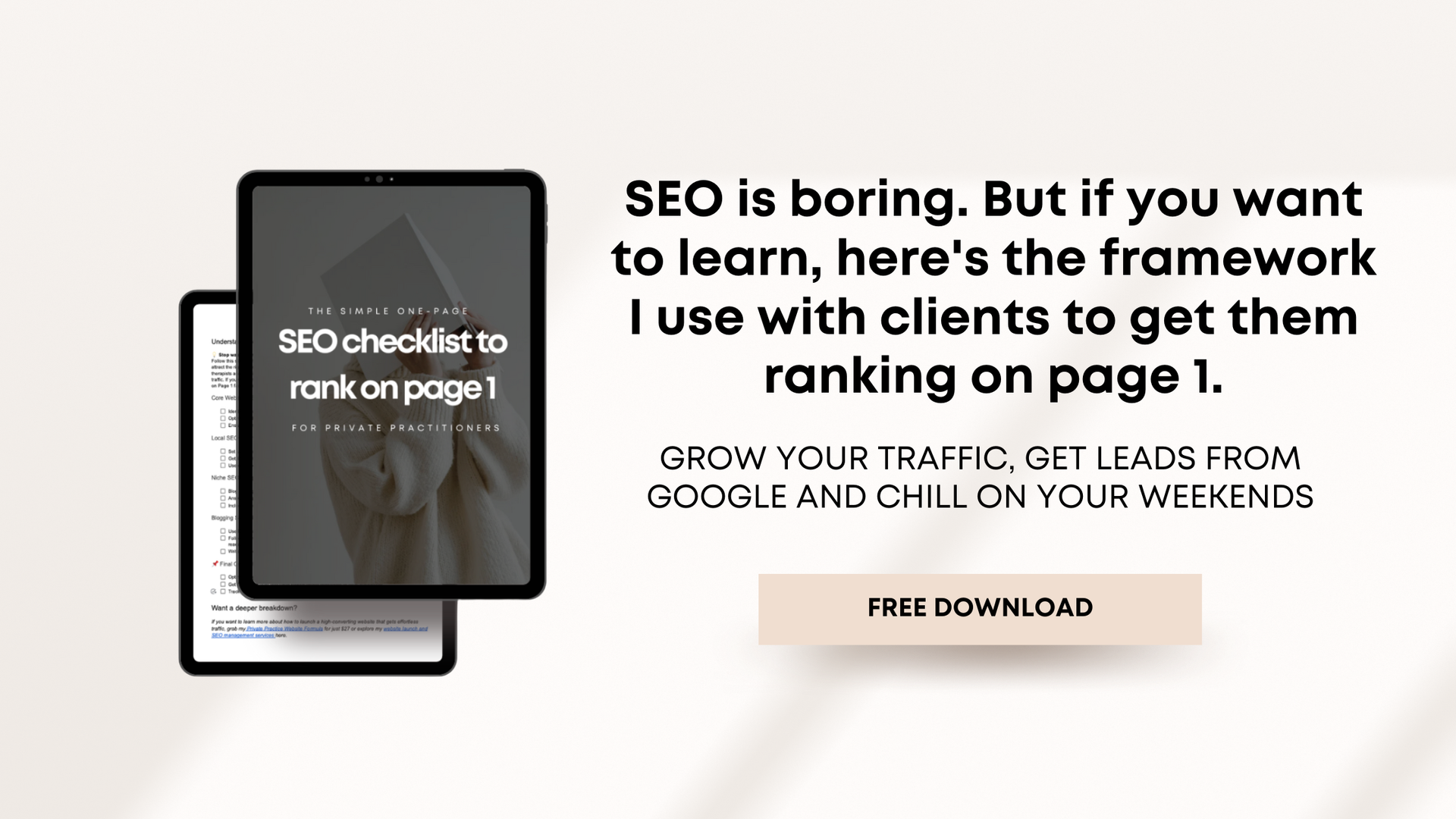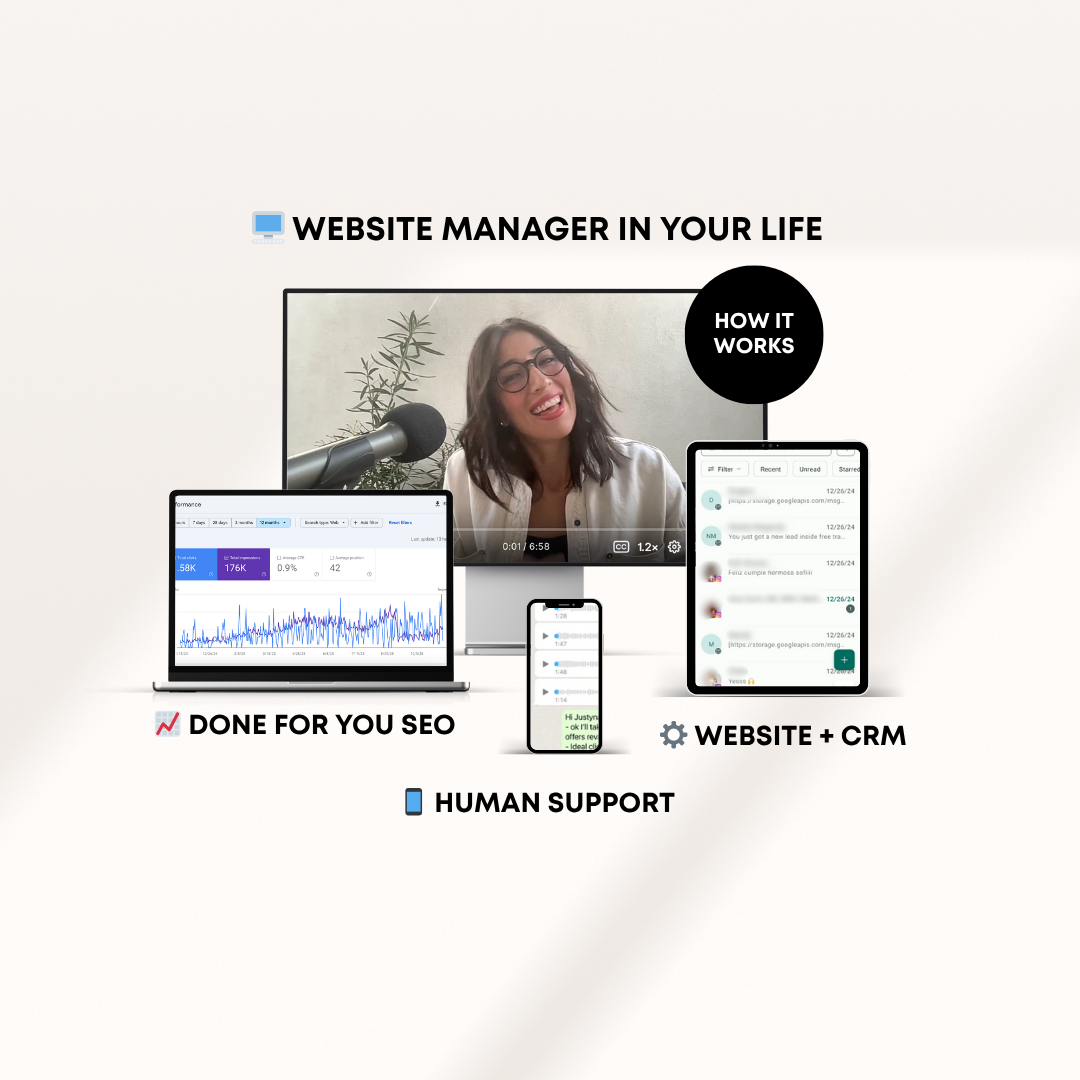10 simple ways to get more therapy clients for your private practice
Looking to grow your therapy practice and attract more clients? Well, you're in the right place! In this blog post, we'll explore 10 simple and effective strategies that will help you get more therapy clients. Whether you're a mental health professional, therapist, or life coach, these tips will give you the confidence to expand your reach, market your services, and build a thriving private practice.
Hey there! I'm Natalia Maganda, a
web designer for therapists and mental health professionals
.
My goal is to help you amplify your magic, gain visibility, and simplify your marketing efforts through strategic web design and content. So let's dive into these 10 simple ways to get more therapy clients!
10 simple ways to get more therapy clients
1- Set up a Google My Business profile
One of the easiest ways to attract local clients is by setting up a Google My Business profile . This free tool allows you to create a professional online presence where potential clients can find information about your practice. It also helps improve your visibility in local search results.
To get started, simply visit the Google My Business website and follow the prompts to create your profile. Make sure to provide accurate contact information, including your address, phone number, and website. You can also add photos and descriptions to showcase what makes your practice unique.
2- Look for therapy directories
Another effective way to increase your client base is by listing your practice in therapy directories. These directories are often visited by individuals actively seeking therapy services, making them an ideal platform to connect with potential clients.
Psychology Today
: One of the most well-known therapy directories, Psychology Today allows you to create a detailed profile that can include your specialties, approach, and credentials.
Visit Psychology Today.
TherapyDen
: TherapyDen is a modern, inclusive directory that prioritizes diversity and inclusivity. It's a great platform for therapists who value these principles and want to reach a broad audience.
Visit TherapyDen
.
Zencare
: Zencare focuses on making the process of finding a therapist easy and straightforward. You can create a profile with videos, photos, and detailed information about your practice.
Visit Zencare
.
GoodTherapy
: GoodTherapy is dedicated to promoting ethical therapy and connecting clients with therapists. You can create a profile and reach a wide audience of individuals looking for therapy services.
Visit GoodTherapy
.
Theravive
: Theravive is a network of licensed therapists who are committed to clinical excellence. Listing your practice here can help you reach clients who are seeking high-quality therapy.
Visit Theravive
.
NetworkTherapy.com
: This directory connects therapists with clients by providing detailed profiles that highlight your specialties and therapeutic approach. It's a useful tool for increasing your client base.
Visit NetworkTherapy.com
.
Open Path Collective
: Open Path Collective offers affordable therapy options and helps connect clients with therapists who offer reduced rates. It's a good platform if you want to provide affordable care.
Visit Open Path Collective
.
Therapists.com
: This directory provides a straightforward way for clients to find therapists based on their needs and location. It's a useful resource for increasing your visibility and attracting more clients.
Visit Therapists.com
.
BetterHelp
: BetterHelp is a popular online counseling platform that connects therapists with clients seeking online therapy. Creating a profile on BetterHelp can help you reach a wide audience and provide therapy services remotely.
Visit BetterHelp
.
3- Attend networking events
Networking events provide an excellent opportunity to connect with fellow professionals in the field and potentially generate referrals for your practice. By attending these events, you can build relationships with like-minded individuals who may refer clients to you or collaborate on future projects.
Look for local networking events, conferences, or workshops related to mental health and therapy. Be prepared to introduce yourself and your practice in a compelling way that sparks interest and leaves a lasting impression.

4- Build a referral network
Word-of-mouth is a powerful marketing tool in the therapy industry. Building a referral network of satisfied clients, colleagues, and other professionals can greatly expand your client base.
Reach out to former clients and ask if they would be willing to provide testimonials or refer their friends and family to your practice. Additionally, consider collaborating with other therapists or healthcare providers who complement your services. By referring clients to each other, you can create a mutually beneficial relationship that helps both practices grow.
5- Look for speaking events
Speaking at events related to mental health and therapy is an effective way to position yourself as an expert in your field. It allows you to showcase your knowledge and connect with potential clients who are seeking professional guidance.
Research local conferences, seminars, or community gatherings where you can offer valuable insights through speaking engagements.
6- Market your business on social media
In today's digital age, social media platforms have become essential tools for marketing any business, including therapy practices. Utilize platforms such as Facebook, Instagram, Twitter, or LinkedIn to reach a wider audience and engage with potential clients.
7- Launch a website
A professional website is a must-have for any therapy practice. It serves as a virtual storefront where potential clients can learn more about your services, approach, and expertise.
Invest in a well-designed website that reflects the unique personality of your practice. Ensure it is user-friendly, mobile-responsive, and optimized for search engines. Include informative content such as an about page, services offered, testimonials, and contact information. Consider adding a blog or resource section to showcase your knowledge and provide valuable insights to visitors.
8- Start a newsletter
Building an email list and sending out regular newsletters is an effective way to stay connected with current and potential clients. By providing valuable content directly to their inbox, you can establish yourself as a trusted resource and maintain top-of-mind awareness.
Encourage visitors to sign up for your newsletter by offering a free resource such as an e-book or mini-course related to mental health or personal growth. Send out newsletters on a consistent basis, sharing updates about your practice, helpful tips, success stories, or upcoming events. Remember to keep the content engaging and relevant to your audience's needs.
9- Start a blog
Blogging is a powerful tool for establishing credibility and attracting organic traffic to your website. By regularly publishing informative and engaging articles related to therapy and mental health, you can position yourself as an authority in your field.
Identify common pain points or questions that your target audience may have and create content that addresses those topics. Share personal anecdotes, case studies, or practical advice that demonstrates your expertise and empathy. Don't forget to optimize your blog posts with relevant keywords to improve their visibility in search engine results.
10- Pay for lead generation ads
If you're looking for a more immediate boost in client acquisition, consider investing in lead generation ads. Platforms like Google Ads or Meta Ads allow you to target specific demographics based on location, interests, or behavior patterns.
Create compelling ad copy that highlights the unique benefits of your therapy practice. Drive traffic to a dedicated landing page where visitors can learn more about your services and easily contact you.
Implement these simple and effective strategies to attract more therapy clients and build a thriving private practice.
Remember, success is within reach when you have the right tools and strategies in place.
If you're ready to take your therapy practice to the next level, I invite you to check out my
website services for therapists.
Don't miss out on this opportunity to simplify your marketing efforts and amplify your impact in the world of therapy and coaching. Together, we can create a thriving private practice that allows you to make a meaningful difference in the lives of your clients.
Related reads:
- Therapist networking tips and where to find online events
- How to write an engaging Psychology Today profile
- Blogging basics for therapists and 140 blog post ideas
- SimplePractice vs TherapyNotes in-depth comparison
- The guide to branding your therapy and private practice
- 20 modern therapist logo ideas
- 80 mental health and therapy quotes to uplift your day

* AI Disclosure: This content may contain sections generated with AI with the purpose of providing you with condensed helpful and relevant content, however all personal opinions are 100% human made as well as the blog post structure, outline and key takeaways.
* Affiliate Disclosure: Some of the links on www.nataliamaganda.com may contain affiliate links meaning that I will get a commission for recommending products at no extra cost to you.

hello! i'm natalia
Latina, web design expert for mental health professionals.
I help ambitious life coaches, therapists and holistic leaders amplify their magic, gain visibility, and simplify their marketing efforts through strategic web design and content.
If you’re looking for an all-in-one system to manage your website, emails, funnels, and CRM, Go HighLevel (affiliate link) is the most powerful tool I’ve tested—and it’s built to grow with you.
On a tighter budget or just starting out? ThriveCart (affiliate link) offers a one-time payment option and easy checkout setups that still pack a punch for digital offers and automation. (Send me an email after your purchase and make sure to use my affiliate link)






